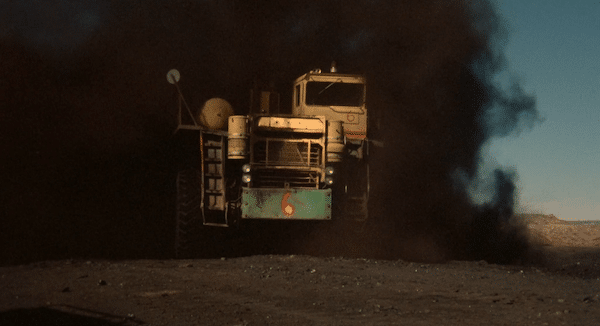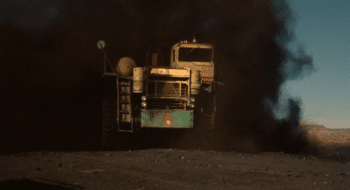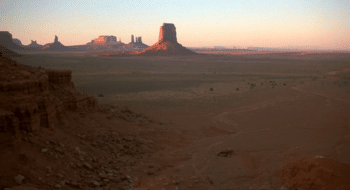“If we dig precious things from the land, we will invite disaster.” Thus reads one of the Hopi prophecies which echo throughout Philip Glass’s haunting soundtrack for Koyaanisqatsi (1982). As those familiar with Godfrey Reggio’s cult film know, the title itself refers to “a state of life that calls for another way of living,” a sharply polemical framing of what otherwise appears, at first, to be a detached, objective representation of humanity’s technological encroachment upon nature. What Koyaanisqatsi pioneered still makes for exciting (and unsettling) cinema. Its cinematography, editing, tempo shifts, and music are all marshalled to the end of replicating in art how technology, as a totality of forms and methods, has drawn everything into its domination. (Here is Reggio speaking of this totalizing “environment of technology” as something more or less akin to ideology—the invisible background of existence which “is unseen and goes unquestioned.”)
But as the global climate crisis worsens, with more and more evidence linking ecological collapse to the limitless expansion of growth that characterizes the irrational logic of capitalism (in what has been aptly named the capitalist “treadmill of accumulation”), Koyaanisqatsi increasingly looks like a dire plea for planetary survival—we must urgently turn from the path of capitalist “business as usual,” specifically in the burning of fossil fuels, or face irreversible consequences for the biosphere, perhaps even for human life itself.
Critiquing Ecological Modernization
Koyaanisqatsi’s concerns, read in this way, overlap to a degree with the critical sociological project of John Bellamy Foster, Brett Clark, and Richard York—especially in their substantive compilation, The Ecological Rift: Capitalism’s War on the Earth(2010). Foster, Clark, and York (henceforth FCY) have been at the forefront of a compelling project of Marxist ecosocialism, which seeks to revitalize the dialectical-ecological ideas of Marx and Engels in order to develop a robust socialist theory encompassing history, nature, the biosphere, climate change, and the social relations of production.
Many of FCY’s arguments critiquing capitalism as the instigator and sustainer of ecological destruction are becoming an integral feature of socialist discourse. These include their definition of capitalism as a “system of self-sustaining value,” a “treadmill of accumulation,” and (one of the most notable of Marx’s metaphors) a “metabolic rift” in the natural-social fabric of production. Capitalism is, as Marx wrote in the Grundrisse, an “endless and limitless drive to go beyond its limiting barriers,” including especially planetary boundaries. Following climate scientists, FCY identify seven such planetary boundaries which serve to maintain an overarching, regulating metabolism conducive to life, only one of which is climate change. To cross any one of these boundaries—and we have already crossed three—”signifies the onset of irreversible environmental degradation.”
Another important component of FCY’s argument is a thoroughgoing critique of an ecological modernization approach, the proposition that the only “way out of the ecological crisis is by going further into the process[es] of modernization” which have led to the crisis in the first place. This is embodied in the weak attempts (or lack thereof) by mainstream economists and social scientists to address accelerating problems of climate change. These ostensible experts advocate a variety of dubious solutions, such as sacrificing the future liveability of the planet to maintain current levels of economic growth, waiting for a miracle technological fix that will “dematerialize” the economy from the physical earth, or even working toward explicitly non-socialist, modest reforms (along the lines of Greta Thunberg or the Democratic Party).
All of these “solutions” sought by ecological modernization, however, leave intact the basic structure of capitalist social relations and, by extension, feed into capital’s limitless accumulating drive. In addition, they espouse a view of nature which reduces the environment to mechanism and mere units of input and output to be optimized so that the economy can keep on running as it should. “Sustainability,” write FCY, like the market buzzword green, “is thus defined entirely in terms of economic growth, monetary wealth, and consumption, without any direct reference to the environment” (113).
Theorizing a Dialectical Ecology
But one of the more unexpected and fruitful arguments that emerges in The Ecological Rift out of FCY’s theoretical nexus has to do with the philosophy of science itself, as well as the potential contours of an all-encompassing scientific theory able to bring together the environmental, the economic, and the social—in other words, a dialectical ecology, or what amounts to a Marxist-infused natural science. There is a lot to say about many features of FCY’s project, but this last point is especially worth thinking about, given too how it builds on but complicates Koyaanisqatsi’s central themes.
One way to conceive this kind of dialectical ecology is to situate it against an alternative scientific paradigm, one tied to the processes of modernization. The natural sciences we know today were born concurrently with the philosophies initiating the modern world. As these sciences developed a positivistic form, they came to be associated with general, unchanging laws about fundamentally discrete objects or processes in nature. Ironically, although positivism rejected the arguments of metaphysics, the outline of its form remained vaguely metaphysical in this tendency toward universal explanation and categorization. This was the case whether the universe was conceived in terms of a causal, mechanistic contraption or, alternatively, a living vessel propelled by invisible sparks of vitality.
The evolutionary ideas of Darwin grew out of this paradigm but presented a major route out of it. In part, Darwin’s materialism was a return to an older materialism—that of of Epicurus, in which contingency, rather than determinism or teleology, was the grounding principle of nature’s forces. This contingency at the heart of nature led Darwin in new directions; but, according to FCY, Darwin still veered toward an environmental determinism with his theories of adaptation and niche. For Darwin, evolution proceeds by chance, but the environment provides the more or less static ground for the direction of evolution.
And so, to refocus dialectical ecology: in between Darwin and the “New Atheists” like Richard Dawkins, who reductionistically posit the gene, rather than the environment, as a determinative element, FCY bring in evolutionary scientists like Richard Lewontin and Stephen Jay Gould to highlight the dual, interactive evolutionary interplay between the environment and the genetic. As Lewontin argued: “Evolution is not an unfolding but an historically contingent wandering pathway through the space of possibilities.”
For these scientists, the “organism is both subject and an object in the physical world,” a scientific principle which draws from and extends Marx’s dialectical materialism to evolution itself:
“The dialectical view emerging from ecology is anything but lifeless or mechanical; it has generated a view of nature no longer shorn of life, interconnection, and sensuous realty—no longer deterministic—but a world of coevolution, contradiction, and crisis… Neither mechanism nor vitalism, neither determinism nor teleology, were adequate in the ecological realm—a realm that demanded an understanding that was at once genetic and relational.” (245)
Balance or Dialectics?
FCY’s argument here, following Marx, is that nature has a specific history. This is a history in which organic life, inclusive of humanity, acts on and changes the world, at the same time as the world acts on and changes organic life. The two are enmeshed in an ongoing, dialectical interplay, a “metabolic” relation that is never the same but that has a discernible historical contour. Thus, the best way to understand the world, in both social and scientific terms, is to look at not only social history but natural history, and to look at them together.
This highlights an important feature of the metabolic rift theory, one that differentiates it from the powerful but ultimately less substantive ideas about the environment and human action put forth by Koyaanisqatsi. In centering modern technological development itself as the underlying cause of humanity’s rupture with the natural world, Koyaanisqatsi swings toward an unchanging, idealistic view of nature, one that sees the environment in terms of an “ideal, natural state”—a lost Eden which could be regained with the removal of industrial civilization. Koyaanisqatsi shares this outlook with other trends in environmentalism like deep ecology and the Gaia hypothesis. The ultimate goal, for these proponents, is to achieve a grand balance between humanity and nature.
Such a view overlaps in part, of course, with FCY’s critique of ecological modernization and its mechanizing view of nature. But FCY astutely point out the limitations of this “balance of nature” theory:
“Why would there be a grand balance in nature? Natural history is a record of drastic changes and discontinuities in the biophysical world. The assumption of a natural harmony is not consistent with a critical historical understanding of nature.” (260)
(This, of course, raises some interesting questions for theology, which I can’t get into here, but even the most diehard proponent of Intelligent Design would have a hard time reckoning with the great imbalances nature presents. I think that Annie Dillard’s Pilgrim at Tinker Creek is useful here as perhaps a covert meditation on theodicy in light of the chaos of nature.)
Moreover, rather than investigating the social and material forces that have driven history and environmental crisis—the advent and growth of capitalism, in particular—the balance of nature theory focuses almost exclusively on a moral imperative for change. “Change becomes a matter of adjusting values and developing the proper eco-ethics, and from there, it is assumed changes in the social structure will follow” (emphasis mine). “Life out of balance” must become “life in balance,” and our climate dilemma is solved.
As I mentioned, this overlaps to a degree with FCY and is certainly compelling in its own way. But FCY show how a dialectical, materialist ecological approach—one informed both by Marx and evolutionary biology—is better equipped to understand and address the challenges posed by ecological rupture, precisely because it is not about nature as balance but about nature as change itself:
“A dialectical materialist approach to nature provides the means for understanding the complex interactions throughout the natural world, the ability to explain the world in terms of itself. It involves both the capacity to recognize that contingency and emergence are inherent aspects of a living world, and the capability to study the structural constraints and the inherent potential for change.
In this, a materialist dialectic avoids the mechanistic reductionism of economistic approaches, where nature exists in the background… It also avoids the idealized notion that nature exists in a state of balance and that a return to such a state is simply a matter of developing the appropriate moral-ethical system.” (270, my emphasis)
Dialectical Theory for an Ecosocialist Practice
What does all this mean for ecology and socialism? First, that we confront the world as it is, full of its limitations and as a history of contingencies which have led only to this one, present set of circumstances, with all of its problems and potential. Part of the way human life has acted upon the world includes the development of the capitalist mode of production, which has threatened the planet’s functional boundaries.
But within this contingent reality lies also the possibility to do things differently; the world as it is now contains the seed and impetus of the world to come, not by teleological decree but by the social-ecological relations we politically choose to foster in our relationships of production. Ecology and the biosphere constitute a two-way interaction between humanity/life and nature. And so we are always in a position to shape our trajectory, not just through moral and scientific shifts but through political action.
Notably, this trajectory of change is not linear or progressive, but proceeds in an irregular series of fits and starts. FCY remind us that, for Marx and Engels, “change is not typically smooth and continuous but rather often occurs very rapidly following periods of stasis.” Long periods of inaction, in both the social and natural worlds, can give way to abrupt, decisive moments of revolutionary change, when the cries of the people and the planet meld together to push for an alternative way of life free of capitalist alienation. Although the outlines of this alternative path are necessarily blurry from the standpoint of the present, it must take the form of a “society of associated producers” in tune with nature’s boundaries—a vision famously sketched, in the negative, in Marx’s Critique of the Gotha Program.
In short, FCY’s theories equip us not just with a more accurate understanding of the interconnected physical and social world on its own terms, but in true Marxist fashion, they also enable us to more effectively change it, directing it toward an unalienated future.
Books Discussed:
John Bellamy Foster, Brett Clark, Richard York, The Ecological Rift: Capitalism’s War on the Earth





